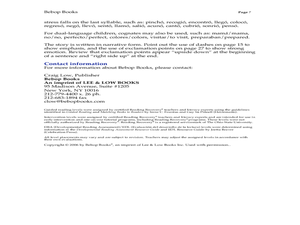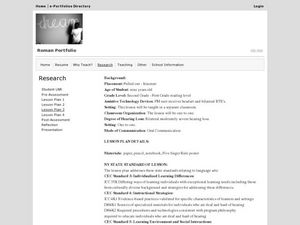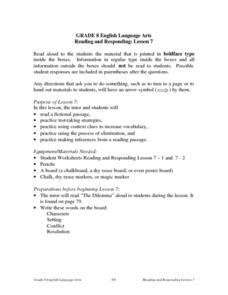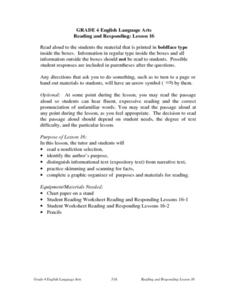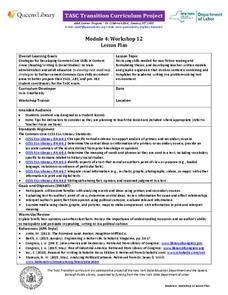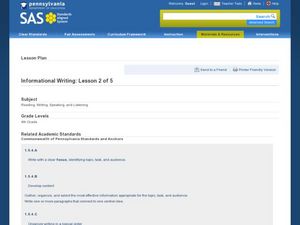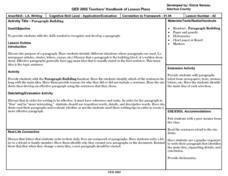Curated OER
Lesson 3: Distinguishing the Author's Purpose
It is true that the more you practice something, the better you'll get at doing it. Lesson three in a three part series on author's purpose has kids venture out to determine the author's purpose in three different passages. They'll read...
Curated OER
Author's Purpose
Sixth graders brainstorm the reasons authors write, and they list their responses on the board. Students discuss each purpose they have listed.Students work independently to read the selection "Tarantulas and Typhoid" by Stephanie Moss....
Curated OER
Author's Purpose
A simple activity for young readers, this introduces the idea of author purpose. Learners analyze various types of texts (newspaper articles, magazines, books, advertisements, etc.) and determine if the author's purpose for writing was...
Curated OER
Reading and Responding: Lesson 3
Reinforce comprehension of informational text. This is a one-on-one lesson intended to build an internal dialogue the reader can use to boost overall comprehension. They work independently with a tutor or teacher to read a nonfiction...
Curated OER
Lesson 4: Author's Purpose
Learners identify the author's purpose in various poems from the book Words with Wings: A Treasury of African-American Poetry and Art. In order to determine the purpose, pupils first observe as the teacher completes a PIES char...
Curated OER
Guided Reading with Elizabeti's Doll
Practice reading strategies using Elizabeti's Doll by Stephanie Stuve-Bodeen. Readers utilize decoding and comprehension strategies before, during, and after reading the story. A detailed list of text features, high frequency words,...
Idaho State Department of Education
Lessons for Social Studies Educators
Point of view, purpose, and tone: three concepts readers of primary and secondary source materials must take into account when examining documents. Class members view a PowerPoint presentation and use the SOAPS strategy to identify an...
Curated OER
Author's Purpose
Learners identify the key components to determining the author's purpose in literature. They read a short selection and answer four key questions. Student chart the responses. They discuss the responses and identify the author's purpose.
Curated OER
Fiction vs. Nonfiction
Young scholars explore fiction and nonfiction writing. They identify the elements of fiction in a short story and identify the criteria necessary in a nonfiction piece. Students distinguish the author's purpose in an expository text,...
Curated OER
Reading And Responding: Lesson 15 Nonfiction
Eighth graders examine a nonfiction selection in a teacher led instructional activity. They examine the author's purpose for writing the selection and identify the difference between fact and opinion. The compare and contrast expository...
Curated OER
Understanding and Stay Interested in Reading
Second graders make predictions about reading. In this remedial reading activity, 2nd graders read a favorite author's story, and read about an animal or favorite hobby or how-to. Students discuss the various purposes for the different...
Curated OER
Reading and Responding -- Lesson 7
Fourth graders work individually or in a small group to (1) read a nonfictional selection, (2) identify main idea and details, (3) identify the author's purpose, and (4) practice test-taking strategies.
Curated OER
Reading and Responding -- Lesson 16
Fourth graders work independently or in a small group to (1) read a nonfiction selection, (2) identify the author's purpose, (3) distinguish informational text from narrative text, (4) skim and scan for facts, and (5) complete a graphic...
Curated OER
Reading and Responding
Fourth graders read and respond to poetry. They identify the author's purpose and connect the literature to their personal experiences. Students critically analyze the poem and write a poem of their own.
Curated OER
Walk Two Moons: Question Answer Relationship Strategy
Middle schoolers develop a strategy as they read excerpts from Walk Two Moons. Using question and answer relationship strategies class members bolster their reading comprehension as they appropriately identify and create questions.
Shmoop
ELA.CCSS.ELA-Literacy.RL.11-12.3
Identifying an author’s choice, especially choices that concern craft and literary devices, is a difficult skill to teach. Here's an activity that will make your job easier. The resource breaks down how to teach the skill to novice,...
EngageNY
TASC Transition Curriculum: Workshop 12
How can opinions slant facts? Workshop participants learn how to examine primary and secondary sources and identify the author's point of view. They also examine how visual art impacts the meaning and rhetoric of sources. Full of...
Curated OER
Sampling Bias And the California Recall
Using a 2002 California Gray David recall vote as an example, young statisticians identify sources of bias in samples and find ways of reducing and eliminating sampling bias. They consider ways to select random samples from a...
Pennsylvania Department of Education
Informational Writing: Lesson 2 of 5
Introduce expository writing to your elementary learners. Young authors write a three-paragraph informational paper using the steps of the writing process. They follow guided lessons to experience each of five steps. Included are tons of...
Curated OER
Lesson Three: Prepositions
Learning prepositions can be tricky in any language, and English is no exception! Try out the activities described here to help your English language learners grasp the difference between in and on and through and by. After a game of...
Curated OER
Paragraph Building
Build the skills your budding authors need to develop to compose well-structured paragraphs. Give them the topic sheet (included here), and have them write a cohesive paragraph using the ideas listed. Consider having them include two...
Curated OER
No Regrets: a Poetry Analysis
Learners read a poem and use the TPCASTT strategy for analysis. In this poetry analysis lesson, students journal about their future goals and read John Updike's "Ex-Basketball Player." Learners discuss the purpose of the poem and...
Curated OER
Understanding Genres
Young scholars identify genres of literature. In this literature instructional activity, students read definitions of the various genres. Young scholars choose books and list clues in the texts that help them identify the appropriate genre.
Curated OER
Making Connections: I Know Why Caged Birds Sing
Students discuss equality and fairness by reading a Maya Angelo poem. In this U.S. history lesson, students read the poem I Know Why Caged Birds Sing, and discuss how the era it was written in affected the words. Students identify the...







